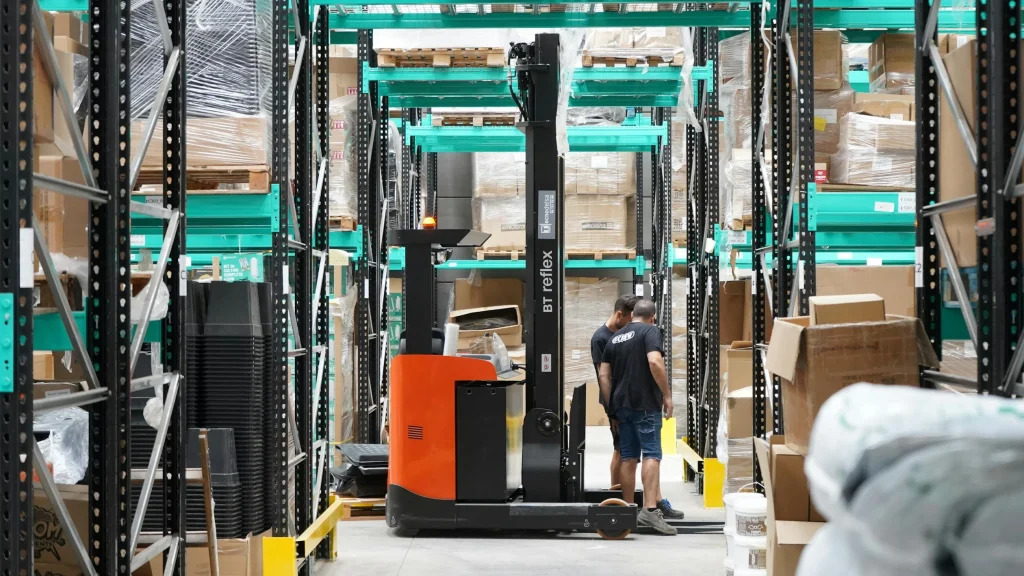E-commerce Warehouse | E-commerce Fulfillment Center
E-commerce Warehouse/E-commerce Fulfillment Center
A demanding consumer who demands the greatest service from a business is a direct result of the e-commerce industry’s phenomenal growth and expansion, which gives consumers a wide range of options. In a situation like this, e-commerce firms must do everything in their power to give customers value and happiness within a set time frame.
Order management and warehousing, two essential elements of the e-commerce ecosystem, can be closely monitored by an e-commerce company to guarantee this. As soon as an order is received on the portal, an e-commerce system is activated. The order is then routed to an online fulfillment center or e-commerce fulfillment warehouse and delivered to the customer.
The fulfillment center is essential to guaranteeing the order is delivered on time in this series of activities. And using Standard Operating Procedures (SOPs) to standardize important procedures is the best approach to guarantee the efficient operation of an e-commerce fulfillment center, also known as an online fulfillment center. The purpose of this article is to inform readers about the process of standardizing and integrating SOPs into e-commerce fulfillment centers and warehouses. In the fulfillment management process, also known as the e-commerce warehousing process or the e-commerce fulfillment process, let’s examine the following crucial areas:
SOPs' function in an online fulfillment center
Our Services
- SOPs Writing
- Layout Designing
- Warehouse Consulting
- E-commerce Consulting
FAQs
How may the order fulfillment process be made better?
Important factors to simplify the order fulfillment process in e-commerce:
Inbound procedure: To guarantee error-free order fulfillment, the inbound procedure up until the putaway phase is crucial. Order delays, incorrect product deliveries, and orders for out-of-stock items can result from inadequate or incorrect putaway systems.
Outbound Process: Since the outbound process begins as soon as the customer’s order is received, it must be completed on time all the way to the last mile delivery. Customer discontent results from any delays in the outgoing process, which cause delays in orders.
Inventory management: The majority of order fulfillment issues that lead to customer discontent are caused by real-time inventory not being available on the online sales channel. For instance, defective things being sold online, out-of-stock items still being available for purchase, incorrect item descriptions displayed online, etc. In order to prevent order failures, inventory management procedures must be coordinated.
Speak with TRS Experts to learn more about how to enhance your order fulfillment procedure.
How do warehouses for e-commerce operate?
Let’s examine this using the following e-commerce warehousing process flow:
Inbound Process: The suppliers will deliver the stock to the warehouse after the purchase order is placed with them. Gate-entry, GRN, QC, and put-away are all part of the incoming process that begins as soon as the product arrives at the warehouse. Following put-away, the inbound procedure is finished, and all of your approved, quality-checked product is prepared for online sale. After put-away is finished, the merchandise is immediately available for purchase online thanks to inventory synchronization between the ERP and website platform.
Outbound Process: A customer’s order initiates the outbound process. The Order Management System (OMS) helps the warehouse get notifications of online orders. The warehouse crew will begin the process of selecting, packing, and delivering the items.
Last Mile Delivery and Returns: It’s critical to maintain a record of both orders that were successfully delivered to clients and those that were returned because the client was unavailable. Managing returns is crucial since the customer service team must be informed and actions must be taken in accordance with return rules.
In order to investigate “5 Easy Tips for ECommerce Inventory Management,”
How do I set up an e-commerce warehouse?
Important actions for setting up an e-commerce warehouse:
Architectural and functional layouts are included in layout planning. Experts in e-commerce provide functional layouts, whereas architects or structural engineers create architectural layouts. To discover the “7 Steps to Design E-Commerce Warehouse Layout,” click this link.
Plan of Business: Verifying the investment’s viability and impact on the total return on investment for the company is crucial. Analyzing whether it would be advantageous to outsource to a 3PL warehouse operator or whether an internal e-commerce warehouse would be necessary is another crucial factor.
Warehouse Civil Work and Interiors Setup: To guarantee that operations can begin quickly, the setup must be prepared well in advance, depending on the condition of the infrastructure.
SOPs and Systems: IT systems, such as WMS or OMS software, are essential and must be connected with your customer support software and website. In addition to the software, the warehouse and customer service teams must define SOPs for order fulfillment because they will collaborate to manage order fulfillment and returns.
Partners for Last Mile Delivery: To finish the process, LMD partners and courier partners would need to be onboarded. Even for deliveries that are made the first, middle, and last miles, preparation is necessary.
Check out the TRS curated video on “6 Simple Steps to Determine E-Commerce Warehouse Size” if you’re unsure about the dimensions needed for an e-commerce warehouse.
How does the fulfillment procedure work?
Crucial actions in the fulfillment process:
First,: the Order Management System is used to receive orders at the warehouse.
Second: Begin the process of selecting every item in the order. This can be completed for several orders at once.
Third: Pack the goods according to the specified instructions. Make sure the packaging is done in a way that prevents the things from being distorted or damaged when they are delivered to the customer or end user.
Fourth: Send out a notification to pick up items for delivery to last-mile delivery partners.
Fifth: When they arrive for pickup, turn over to courier or last-mile delivery partners.
Sixth: The process will be deemed finished if all of the products in the order have been delivered to the client.
Make provisions for deviations like:
1.Items ordered are not available.
2.Customer returns
3.Returns that are not delivered.
4.COD orders that have not been paid returns.
5.Delays in orders.
How should an e-commerce warehouse be operated?
The following essential requirements can be put into practice to operate an e-commerce warehouse:
1.Specifying the personnel organization for the warehouse: Identifying the team members needed at each grade or level, together with their reporting structure, KRAs, and KPIs, is crucial for defining the warehouse personnel structure. In addition to being financially possible, which must be confirmed within the financial business model, it is crucial to specify the structure in accordance with anticipated inbound and outbound volumes.
To handle inventory and warehouse operations, a warehouse management system, or WMS, must be implemented.
2.Standard operating procedures, or SOPs: should be clearly and concisely defined, particularly for entry-level and blue-collar employees. In addition to thoroughly defined SOPs, video SOPs are strongly advised.
3.Audits and Training: Although system implementation is accomplished successfully, regular training and audits are necessary to keep these systems up to the necessary standards.
Our Services
Get Advice for E-commerce Warehouse | E-commerce Fulfillment Center
Related Blogs
Retail Supply Chain Management Trends and Trots
Starting a Fashion Company: From Strategy to
Retail Revolution: Cutting-Edge SCM Techniques to Boost
Retail Pricing Strategies Explained: A Practical Guide
Related Blogs

Visual Appeal Strategy and Retail Store Layout Planning for 2025
Retouching the Visual Appeal and Layout of Your Store Have you ever had a positive feeling when you entered a store? Alternatively, it might be the opposite. Try to think of a recent memory where you experienced each. Could you remember or explain why you...

How Dynamic Pricing Can Transform the Profitability of Your Retail Store
What does dynamic pricing mean in e-commerce and retail? Consider dynamic pricing to be similar to stock prices. Similar to how stock prices continuously change to reflect various market factors, dynamic pricing involves retailers using software or automation to modify goods prices.

A Complete Manual on Retail Pricing Techniques: Selecting the Best Strategy for Your Company
For retailers, setting the proper pricing for their goods is crucial. There are limitations from a marketing perspective, and there is also pressure to cover expenses. Costs can be calculated, but assessing the quality and quality of...

Standard Operating Procedures
Considering launching an eCommerce company or moving your company online? Consult with professionals in the field.









